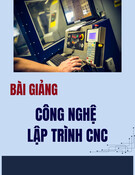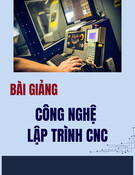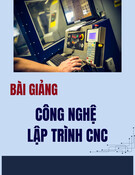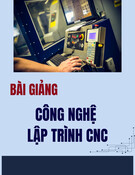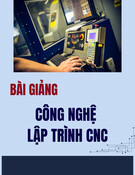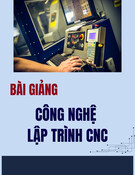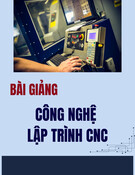
Vu Duong, Le Hong Ky / Tạp chí Khoa học và Công nghệ Đại học Duy Tân 04(65) (2024) 49-59
49
Influence of some parameters in atmospheric plasma spray on particle
kinetics
Ảnh hưởng của một số thông số trong phun plasma khí quyển đến động học hạt
Vu Duonga,b*, Le Hong Kyc
Vũ Dươnga,b*, Lê Hồng Kỳc
aSchool of Engineering Technology, Duy Tan University, Da Nang, 550000, Vietnam
aTrường Công nghệ, Trường Đại học Duy Tân, Đà Nẵng, Việt Nam
bInstitute of Research and Development, Duy Tan University, Da Nang, 550000, Vietnam
bViện Nghiên cứu và Phát triển Công nghệ Cao, Trường Đại học Duy Tân, Đà Nẵng, Việt Nam
cVinh Long University of Technological Education, Vinh Long, 890000, Vietnam
cĐại học Sư phạm Kỹ thuật Vĩnh Long, Vĩnh Long, Việt Nam
(Date of receiving article: 20/01/2024, date of completion of review: 19/02/2024, date of acceptance for posting:
02/03/2024)
Abstract
The study focuses on analyzing the impact of various plasma spraying factors, including plasma current, plasma voltage,
and air flow rate, on particle velocity, given their crucial role in determining coating effectiveness. Notably, this research
innovatively incorporates ordinary air as the plasma-generating gas and introduces a mathematical model that explains
the adjustment of particle velocity. A newly derived regression function aids in optimizing the procedure for
maximizing particle velocity. A thorough investigation validates the parameters' effectiveness, showing strong
agreement between the mathematical model and experimental results. The introduction elucidates the necessity of this
study, while the methodology section details the equipment, analytical instruments, and chemical composition of the
85Ni15Al powder. The experimental phase outlines a series of experiments, employing a multi-criteria planning design
to assess the significance of each parameter effectively.
Keywords: particle velocity; atmospheric plasma spray; ordinary air; plasma generation gas; mathematical model;
regression equation.
Tóm tắt
Nghiên cứu tập trung vào phân tích tác động của các yếu tố phun plasma khác nhau, bao gồm dòng plasma, điện áp plasma
và tốc độ dòng khí, đối với vận tốc hạt, do vai trò quan trọng của chúng trong việc xác định hiệu quả của lớp phủ. Đáng chú
ý, nghiên cứu này kết hợp một cách sáng tạo không khí thông thường như khí tạo ra plasma và giới thiệu một mô hình toán
học giải thích sự điều chỉnh vận tốc hạt. Một hàm hồi quy mới có nguồn gốc hỗ trợ tối ưu hóa quy trình tối đa hóa vận tốc
hạt. Một cuộc điều tra kỹ lưỡng xác nhận hiệu quả của các tham số, cho thấy sự thống nhất mạnh mẽ giữa mô hình toán học
và kết quả thực nghiệm. Phần giới thiệu làm sáng tỏ sự cần thiết của nghiên cứu này, trong khi phần phương pháp luận nêu
chi tiết thiết bị, dụng cụ phân tích và thành phần hóa học của bột 85Ni15Al. Giai đoạn thử nghiệm phác thảo một loạt các
thí nghiệm, sử dụng thiết kế lập kế hoạch đa tiêu chí để đánh giá tầm quan trọng của từng tham số một cách hiệu quả.
Từ khóa: vận tốc hạt; phun plasma khí quyển; không khí thông thường; khí tạo plasma; mô hình toán học; phương trình
hồi quy.
*Corresponding Author: Vu Duong
Email: duongvuaustralia@gmail.com
04(65) (2024) 49-59
DTU Journal of Science and Technology
D U Y T AN UN IVERSI TY
TẠP CHÍ KHOA HỌC VÀ CÔNG NGHÊ ĐẠI HỌC DUY TÂN

Vu Duong, Le Hong Ky / Tạp chí Khoa học và Công nghệ Đại học Duy Tân 04(65) (2024) 49-59
50
1. Introduction
The efficiency and productivity of
atmospheric plasma spray (APS) are highly
dependent on the mean temperature and velocity
of the powder particle prior to impact with the
substrate. Because the condition of the in-flight
particle is very important, B. Guduri et al.
offered their inquiry in depth to set up a stable
and adaptable instrument for obtaining a
consistent value [1]. In the experiment, the
authors employed argon and hydrogen in a
mixture with flow rates of 30–60 standard liters
per minute (slm) and 0–15 slm; current (300–
600 A); voltage (30–70 V); and a plasma torch
diameter of 8 mm. The powder for spraying had
a particle size of 30–100 m, but no mechanical
composition or size distribution was given,
despite the fact that particle size is important in
this complicated operation. ANOVA analysis
revealed that the current and flow rate of argon
had a significant influence on particle velocity.
Although the response functions have been
adequately implemented, more study is required
to create a robust controller.
The velocity of the particle takes precedence
over temperature in the cold spray procedure.
However, the spray distance and powder feed
rate have a significant impact on particle
velocity [2]. The researchers identified the
threshold velocity of the particle, beyond which
it may bond to the substrate surface and form the
coating [3]. In any case, they do not present a
quantitative relationship between particle
velocity and some key technical characteristics.
Because the critical velocity of the particle in
spraying is thought to be a crucial element in
bonding, the researchers in [4] studied particle
behavior in the kinetic spraying of AlSi
feedstock using the method Kurochkin et al. [5]
developed to identify the critical velocity
approaching 400 m/s. It's worth noting that the
particle with a maximum velocity greater than
the crucial one will not be stuck to the substrate
since the adhesion energy is less than the
rebound energy. In [6], a large number of
supersonic plasma sprayings of ceramic powder
(YZS) over the nickel-based superalloy GH
3030 are performed. They obtained a collection
of data that included current, voltage, argon,
hydrogen, feedstock feeding rate, spray distance,
and velocity, but not the assessment and analysis
of the parameters due to a lack of a regression
relationship between them. From this vantage
point, the optimum range of spraying settings to
achieve maximum particle velocity and
temperature is insufficient to persuade. In [7], an
attempt was made to derive a new mathematical
model that included particle and gas velocity,
particle mass, gas density, particle diameter, and
drag coefficient. They compared the
experimental measurement using a dual-slit
velocimeter to the 2-D axi-symmetric
calculation of the flow through the nozzle and
the 1D isentropic gas-dynamic equations
computed for the identical nozzle shape. The
particle size distribution caused a difference in
the theoretical computation of particle velocity.
The major discovery in their investigation is that
particles with velocities greater than the critical
velocity deposit, but bigger particles with lower
velocities do not. The primary disadvantage of
[8] is that the model based on Newton's second
law does not address the technological
parameters in spraying deposition, such as
stream power and gas flow rate, which are more
useful in process design. The most favorable
results were obtained in [9] when the authors
used regression analysis (RA) and response
surface methodology (RSM) to evaluate the
significance of four parameters: the Ar and H2
flow rates; the current and powder feed rates in
the atmospheric plasma spray process; but the
power of the plasma stream also depends on the
voltage, and ordinary air for plasma generation
could have a different impact. Based on the

Vu Duong, Le Hong Ky / Tạp chí Khoa học và Công nghệ Đại học Duy Tân 04(65) (2024) 49-59
51
foregoing reasoning, the goal of this work is to
develop a mathematical model for the theoretical
prediction of particle velocity in plasma
spraying using ordinary air as the plasma-
generating gas, including key factors such as
current, plasma torch voltage, and air flow rate.
In contrast to prior papers on the subject, the
particle material used to deposit the anti-friction
layer is Ni85Al15 powder. The ANOVA
approach aids in determining the importance of
each parameter in the regression equation. The
proposed model of particle velocity prediction
dealing with velocity optimization in future
investigations demonstrated a disparity of less
than 5%.
2. Methodology of investigation
Atmospheric plasma spraying was utilized in
our experiment (SG-100 TAFA-Praxair, USA).
Ordinary air serves as the main gas, while
nitrogen serves as the carrier gas. In [10] they
described the chemical composition and process
of producing Ni85Al15 powders. The particle
size of the powders is determined using the
Cilas-1090 [11] instrument. Table 1 shows the
fractional distribution of powders.
Table 1. The fraction distribution of particle Ni85Al15
Code
Mean
diameter
µm
Particle size fraction, %
0 -1
1-1.5
1.5-2.0
12-16
32-48
48 -64
64- 96
96 -128
Ni85Al
15
64
7.5
8.9
4.1
-
-
72
4.2
3.2
In this case, the powder Ni85AL15 is a good
material recommendation for high-temperature
coatings. This superalloy had a high oxidation
resistance in the temperature range of up to 1250
°C in the atmosphere. Especially the γ Ni3Al
intermetallic phase has a melting point of about
1400 °C, thermal stability up to melting, and an
increased yield point in the temperature range of
800-900°C. This material can be a good
recommendation as a protection coating for
components operating in heavy conditions, such
as jet nozzles, afterburners, and jet blades in
aerospace engineering [12]. The significant
benefit of spraying protective coating on the
aero-engine is available via a reduction in
degradation of 25% and 50% compared to the
uncoated version [13]. It is interesting to note the
efficiency of atmospheric plasma spraying
(APS) over chemical vapor deposition (CVD) in
the repair of the MIG-29 fighter engine due to
the simplicity of the equipment and the
significant reduction in production cost [14].
Scanning electron microscopy combined with
energy dispersive spectroscopy (SEM/EDS,
SM-6510LV, Japan) was used to examine the
surface morphology of the coatings and the
topography of metallic particles. SEM
investigation revealed that the feedstock
particles had an uneven shape.
The Shimadzu HPV high-speed camera is
used to monitor the velocity of spraying particles
[15]. The camera can be used in combination
with available image analysis software. Thus,
high-speed images can be subjected to numerical
analysis by saving the recorded images in a
common format and then loading them into
commercially available image processing
software. The recorded images can be saved in
some common formats, such as AVI, BMP,
JPEG, and TIFF. The camera is working in two
modes: half-pixel mode (HP) and full-pixel
mode (FP). Figure 1 depicts the plasma spraying
system. The plasma-generation gas is ordinary
air. The carrier gas is also ordinary air. Ordinary
air is a molecular gas that must be dissociated
before it can be ionized. This means that

Vu Duong, Le Hong Ky / Tạp chí Khoa học và Công nghệ Đại học Duy Tân 04(65) (2024) 49-59
52
ordinary air has greater enthalpy and thermal
conductivity than argon plasma. Consequently,
the molecular gases consume much higher input
energy to become partially ionized. Because it is
made up of excited ions and unbound electrons,
plasma may carry electricity. In plasma
spraying, the plasma-produced gases often
include one or more of the following: argon,
hydrogen, nitrogen, and helium. Argon is
commonly utilized as the main plasma gas
because it is the easiest to generate plasma and
is less aggressive for electrodes and feedstock.
Secondary gases include nitrogen, hydrogen,
and helium. The noble gases are argon and
helium. Despite its cost savings and advantages
in some specialized applications of thermal
spray coatings, there has been nothing published
on the use of common air as a main plasma gas.
Nonetheless, with torch construction innovation
and suitable spraying settings, ordinary air may
be suggested for the wear-resistant coating of
ceramic materials, particularly Fe-based
amorphous alloys [16, 17]. Argon plasma offers
several advantages, but it has a lower thermal
conductivity and enthalpy than binary gases.
Because molecular gases must breakdown
before ionization, the enthalpy and thermal
conductivity of ordinary air plasma are
significantly larger than those of argon plasma.
As a result, they take significantly more energy to
get partly ionized. As a result, the greater the
energy input, the greater the enthalpy, and the
greater the thermal conductivity. This reasoning
reminded me of the substitution of inert and noble
gases for plasma spraying with ordinary air.
The following is a brief summary of how the
system works: G1 is the power
Figure 1. Plasma spraying system
G1 is the source; G2 is the plasma torch; R1
and R2 are rotameters; V1 and V2 are valves;
N1, N2, N3, N4, and N5 are nipples; T1 is the
thermometer; and T2 is the throttle. The power
source is a direct current source with a steep
volt-ampere slope, an idle voltage of 300 V, and
a voltage adjustment range of 50–600 V. The
plasma arc is created in a two-step process.
Water is used as the coolant, with inlet and exit
valves as well as the rotameter R1. The T1
thermometer is used to monitor temperature and
give data for calculating plasma jet enthalpy.
This rotameter has a precision of 2.5. The intake
water flow pressure is 0.4–0.6 MPa. The primary

Vu Duong, Le Hong Ky / Tạp chí Khoa học và Công nghệ Đại học Duy Tân 04(65) (2024) 49-59
53
flow rate. T2 is used to smooth out the current
pulsation.
and secondary gases are fed into the system via
valve V2. The rotameter R2 determines the gas
3. Experiment & result
3.1. Regression equation and the analysis of the variation
Table 2 shows the results of a series of experiments with different input spraying settings and
particle velocity measurements.
Table 2. Result of plasma spraying of the powder 85Ni15Al
No
Plasma current, I
[A]
Potential, U
[V]
Flow rate of
air, G [g/s]
Particle velocity,
V [m/s]
1
130
140
0.55
18
2
130
160
0.75
40
3
130
195
0.34
62
4
130
200
1.13
73
5
130
210
1.42
84
6
130
220
1.76
97
7
130
225
1.95
105
8
130
240
2.72
140
9
130
250
2.92
152
10
150
150
0.55
36
11
150
185
0.84
67
12
150
205
1.13
78
13
150
207
1.42
85
14
150
220
1.76
99
15
150
240
2.41
128
16
150
245
2.92
153
17
150
250
3.17
167
18
180
145
0.55
33
19
180
160
0.75
49
20
180
180
0.84
65
21
180
202
1.13
82
22
180
220
1.76
104
23
180
240
2.60
140
24
180
250
3.17
170
25
220
150
0.55
43
26
220
160
0.75
53
27
220
190
0.94
76
28
220
200
1.13
84
29
220
220
1.76
106
30
220
245
2.60
143
31
220
260
3.17
172
The experimental results have been processed (Table 3 ) using Minitab software and were
preliminarily analyzed.








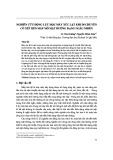
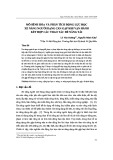

![Bài tập tối ưu trong gia công cắt gọt [kèm lời giải chi tiết]](https://cdn.tailieu.vn/images/document/thumbnail/2025/20251129/dinhd8055/135x160/26351764558606.jpg)




